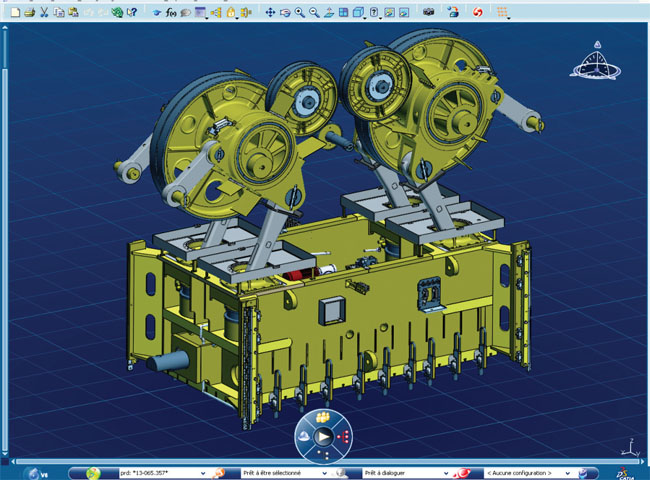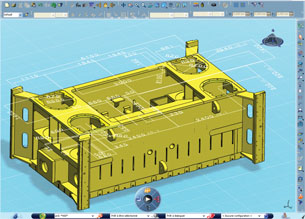DS ENOVIA V6 PLM Enables Market Agility
A world-wide manufacturer of press systems and metalforming solutions improves quality and reacts nimbly to a changing market.
Latest News
October 1, 2009
By Russell Shuba
Since its founding in 1839 as a metal fitter’s shop, Germany’s Schuler AG has become a global manufacturer of mechanical and hydraulic metal-forming products, systems, and services, with annual sales of more than $1 billion and a workforce of 5,710. At the forefront of developing transfer and servo presses widely used across the automotive industry, Schuler pioneered hydro-forming technology for contouring tubes in the 1990s. Its presses are also used in minting and solid forming. Schuler has ten forming system sites in Germany as well as sites in Brazil and China, with advanced technology sites in Germany and the U.S.
 CATIA V6 allows for kinematic simulation of large assemblies, as shown here. |
To maintain its reputation as a leader in the metal-forming sector, Schuler must constantly demonstrate its commitment to innovation, product quality, and customer service. This means reacting quickly to new market opportunities and delivering the quality products its customers expect.
“Schuler’s number one business challenge is to satisfy the changing requirements of our customers such as automotive manufacturers,” says Joachim Beyer, a member of Schuler’s board of directors.
Each of Schuler’s manufacturing sites is responsible for different product parts and processes. The presses themselves are huge, tailored to customer needs, and often comprise more than 30,000 parts with a lifetime of up to 30 years. Each press, let alone the coordination of building a line of them, presents enormous data management and coordination challenges. This complexity requires real-time data sharing and decision making among geographically dispersed engineers, suppliers, and customers. To address these development challenges, Schuler began using Dassault Systèmes’ ENOVIA version 4 product lifecycle management (PLM) solution in 1996 before migrating to V5 in 2003.
Single PLM Platform for IP
Schuler needed a solution that would help it make the most of its intellectual property, enabling all its stakeholders to work together and run with their ideas, according to Walter Knoblauch, PLM manager for Schuler.
As its projects became more complex, Schuler wanted to manage all of its product-centric IP from idea- to product-experience on its single PLM platform. This includes all product-related information or knowledge necessary to design, manufacture, and deliver products to market, as well as modeling applications for engineering disciplines and collaborative business processes that span the entire product lifecycle.
 There are full annotation capabilities available in CATIA V6. |
“PLM could help us to manage our process and product data more efficiently by grouping all this IP in a single environment,” says Dieter Laube, Schuler’s PLM administrator. “For me, the system will be easier to manage because everyone at Schuler will have the same information at the same time.”
Online Collaboration and Authoring
Now, Schuler stakeholders can create and collaborate in real-time from remote locations via a basic Web connection. For example, engineering teams can display, manipulate, or design parts concurrently in Germany and Brazil.
“Online remote collaboration reduces the problem of bandwidth and latency time,” says PLM Manager Knoblauch. “Our engineers can connect and work together simultaneously on the same product and actually model in real-time 3D. Distance is no longer a problem.”
The ability to create and collaborate remotely enables design teams to be more flexible and responsive. It enables engineering managers like Martin Schmeink, who works in Schuler’s automotive business unit to allocate work to sites around the world where resources or expertise is available. “We also use outside contractors for designing in order to meet demand,” says Schmeink. “This application helps us to simplify the process of connecting these small offices and is a great way to adjust to our workload.”
Global Collaboration Enabled
Schuler engineers, suppliers, and customers can now collaborate and innovate on a large scale via the Web, and harness the collective intelligence and creativity among these online communities to design complex products concurrently in real-time at any level of detail. Likewise, business users can collaborate across common business processes, or leverage engineering information.
“One of the significant benefits is that this application can handle large-scale projects,” says Laube. “More disciplines can collaborate on projects, regardless of the factors of size and the complexity of assemblies.”
Because PLM provides interoperability with virtually any other enterprise application, it enables Schuler to access and leverage diverse data sources.
“Having engineering and manufacturing practices integrated with business processes better connects my designers to the rest of the company and our suppliers,” says Schmeink. “For example, my engineers can instantly access sourcing and compliance information, giving them a better chance of getting their design right the first time—we save time and money.”
According to Andreas Schäffer, the company’s CAD manager for hydraulic presses, the V6 interface gives him the ability to instantly and easily find information. “It’s easier to work with geometry on the screen than with words that you find in a traditional interface,” says Schäffer.
Schuler teams can conceptualize, develop, and deliver products in a shared environment over the Web, or access search, navigation, and collaboration capabilities for a real-time snapshot of a product’s status throughout its lifecycle. Better communication results in better products, according to the company.
Breakthrough ROI
With a single platform on one server for all IP modeling and collaborative business process applications, Schuler is reaping a substantial increase in return on investment by reducing the cost of adoption and reducing the time necessary to deploy a full PLM solution.
“With V6, there is only one server for the entire system,” says Laube. ”This means only one server to install, customize, administer, and maintain, which reduces our IT costs overall. We also deploy faster because integrating new sites is now easier.”
The V6 solution enables Schuler to further leverage worker knowledge and skills, and provide its global development teams with the right tools for concurrent engineering.
More Info:
Dassault Systemes
Russell Shuba is a freelance writer with credentials in PLM, interoperability, and simulation processes. To comment on this article, send e-mail addressed to [email protected].
Subscribe to our FREE magazine, FREE email newsletters or both!
Latest News
About the Author
DE’s editors contribute news and new product announcements to Digital Engineering.
Press releases may be sent to them via [email protected].






